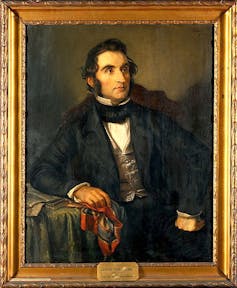
Were it not for Baron Justus von Liebig, Christmas might look and taste quite different. Yet despite his contribution to everything from the stock cubes used in your gravy to the mirrors in your home, it is unlikely you have heard of him.

For much of the 19th century Liebig was a giant of the scientific establishment, with fingers in many pies. He worked out the core nutritional needs of plants and then went on to develop the first fertiliser – for which he is known in scientific circles as the “father of fertilisation”. This work removed the dependency on animal dung to feed crops and paved the way for industrial agriculture – including piles of Brussels sprouts.
The German chemist’s interests also stretched to human nutrition. He became convinced the juices that flowed out of cooked meat contained valuable nutritional compounds and encouraged cooks to sear the meat to seal in the juices. This turned out to be complete bunkum, but 150 years later his advice is still followed by Christmas dinner chefs across the land.
The obsession with meat juices also led him to create beef extracts in an attempt to provide a nutritious meat substitute. The extract turned out to be a rather poor, and not particularly nutritious, alternative to meat – but the Liebig Extract of Meat Company did morph into Oxo, whose stock cubes find their way into so many Christmas gravies.
Mirrors and baubles
Yet Leibig’s most visible contribution to Christmas may well be hanging on your Christmas tree. Christmas trees have their roots as far back as the Roman saturnalian celebration of the winter solstices – a religious festival involving drinking, singing and exchange of gifts, dedicated to the Roman god Saturn. Later, probably sometime in the 16th century, decorated trees were brought into homes and this German idea was then popularised by Queen Victoria in the mid 19th Century.
Some of the first reported glass decorations for trees, dating back to the 16th century, were garlands of beads produced by the Greiner family in Lauscha, Germany. Some 250 years later, the family were still making ornaments, and Hans Greiner became famous for his ornate glass nuts and fruits, decorated with mirrored internal surfaces.
At the time, mirrors were prohibitively expense for most and were made by adhering a thin tin film to glass using mercury. The process was extremely hazardous as it generated highly toxic mercury vapour, which could also leach off the mirror for decades to come. In fact antique mercury mirrors may be identified by droplets of mercury pooling at their base.
At more or less the same time as Hans Greiner was creating his baubles, Liebig was developing much safer ways to silver glassware for use in his laboratories. His method utilised silver nitrate, ammonia and simple sugars. And it resulted in a fabulously uniform, crystal-clear film of silver metal deposited on the glass. This was soon adapted for use in other areas of science, including telescope mirrors, and soon Greiner caught wind of the development and incorporated it into his ornaments. Eventually the process also led to mass-produced mirrors which were cheap enough to make them commonplace.
Shortly after Liebig developed his silvering method the process was tweaked by another German chemist, Bernhard Tollen, who turned the process into an analytical technique for identifying particular chemical groups called aldehydes. Tollen’s technique has the rather beautiful side effect of quickly silvering the vessel it is carried in. Seeing a mirrored surface form in your hands is a real delight, making it a favourite of chemistry lessons the world over.
Mark Lorch, Professor of Science Communication and Chemistry, University of Hull
This article is republished from The Conversation under a Creative Commons license. Read the original article.











